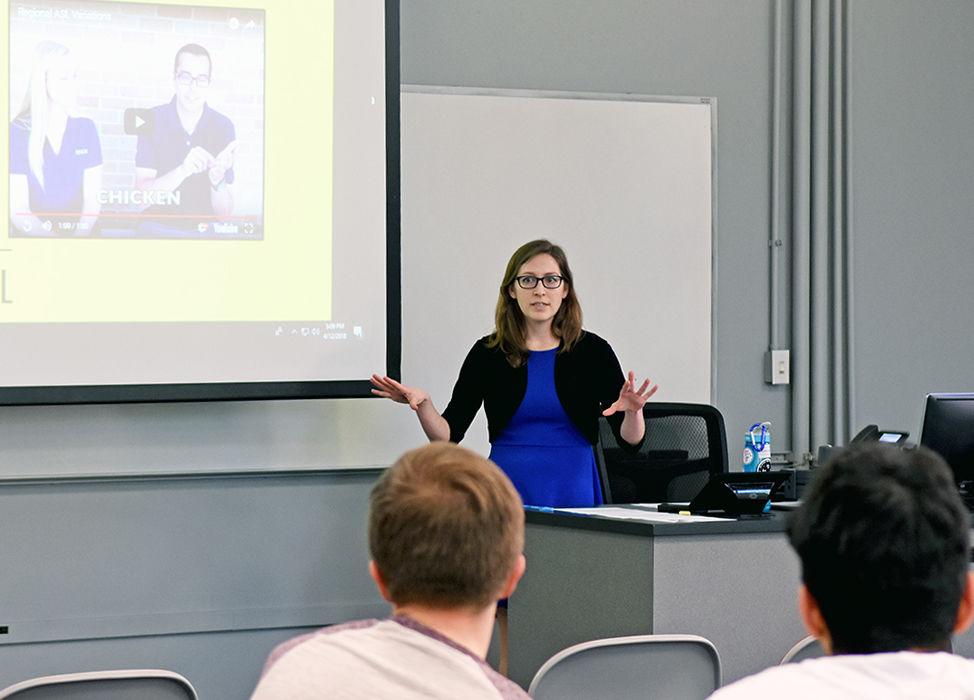The world of nonverbal language matches the complexities of its verbal counterpart. The linguistic variances that spice and diversify all speakers of verbal language also exist in the users of sign language.
Facilitating a discussion on this topic were the Linguistic Diversity Ambassadors of the linguistics department of NC State, who held an event titled “American Sign Language: Dialects and Deaf Culture” on Thursday in Winston Hall.
The dialogue connecting this to American Sign Language was led and explained by Alison Eggerth, a graduate student studying linguistics. She explained the struggles faced historically by users of sign language.
“There was a method invented by Alexander Graham Bell called oralism,” Eggerth said. “It said that if you signed, you won’t be able to learn English as well. It called for deaf people to sit on their hands and be forced to read people’s lips.”
Prior to ASL, oralism was a method used in deaf education that forced oral language comprehension and production.
“ASL wasn’t even recognized as an official language in the United States until the 1960s, so it creates a dichotomy between the people who were raised in the oralist method who said ASL was bad and didn’t use it, versus now, now we have TV shows and movies that celebrates ASL and deaf culture.”
The event covered the benefits, basic facts and myths surrounding ASL. Important topics like that ASL is a linguistically complete language with its own grammar and that not all deaf people can read lips were covered.
Eggerth explained the details of ASL further, moving her hands with her words expressively as she demonstrated the different signs of the alphabet.
“ASL grammar would ask the question, ‘Where is my car?’ like ‘My car where,’” Eggerth said. “The tone that people communicate in signing is determined through non-manual signing, like facial expressions and movements.”
Deaf culture was explained in the event by graduate linguistics student Katie Conner, who explained the practices of deaf individuals in different situations. She outlined how rude it would be to break eye contact while communicating through signing, and how it was important for hearing people to explain and contextualize noises to deaf people instead of expecting them to react to them.
“You can’t always rely on lip reading,” Conner said. “That’s not necessarily a quality every deaf person is innate with.”
A comic strip was shown of a boy explaining that he was leaving a party with his deaf father, which meant an extra 45 minutes. This humored the reality of deaf people having to sign to individual people in gatherings when saying goodbye, which would in turn, take longer than simply being able to communicate a goodbye verbally.
KellyNoel Waldorf, a graduate student studying linguistics, covered the dialects of sign language. She explained how people who are hearing but sign may sign at a different rhythm than deaf people that sign, and they may not always understand each other.
Sign language, like oral language, expectedly varies greatly by national regions and other nations. She explained how ASL was more similar to French Sign Language than to British Sign Language and Australian Sign Language. The nuances of African-American Sign Language were detailed as well.
“Features that are included in African-American Sign Language are bigger manual sign spaces, and you get similarities to spoken African-American English, such as ‘He trippin’,’ and other words,” Waldorf said. “You can see some of those linguistic characteristics crossing over.”
Claudia Pollex, a second-year studying communication and psychology, expressed disappointment with the lack of courses teaching sign language at NC State.
“NC State is the biggest university in North Carolina, and there are rather large deaf communities in Charlotte, Winston-Salem, Greensboro, Raleigh, a lot of the big cities” Pollex said. “I think it says something by the university not having American Sign Language classes to the 200,000 plus residents in North Carolina who are hard of hearing or deaf. I think it’s important as the biggest university that we allow hearing people like me to have access to ASL and be able learn it.”
Like all the traits that make people diverse members of their communities, linguistics holds a range of unique qualities that make it an agent for diversity, and they are also an avenue for discrimination, although a more succinct form of it. This is the reason for the imperative part they play in multidisciplinary education of diversity across university campuses.













